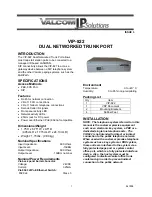
LB9030A-R2_LB9031A-R2_LB9032A-R2
11
UNICAST SWITCHING
VLAN CLASSIFICATION
When the switch receives a frame, it classifies the frame in one of two ways:
- If the frame is untagged, the switch classifies the frame to an associated
VLAN.
- If the frame is tagged, the switch uses the tagged VLAN ID to identify the
broadcasting domain of the frame.
LEARNING
After VLAN classification, the switch checks the <source MAC address,
VLAN> pair in the switching database (SDB) to see whether the <source
MAC address, VLAN> pair is known.
- If it is unknown, the switch inserts the <source MAC address, VLAN> into
the SDB and learns the <source MAC address, VLAN>.
- If it is known, the switch checks the <source MAC address, VLAN> for a
mismatched port ID. If the port ID associated with the <source MAC
address, VLAN> pair in the SDB is different than the receiving port, the
switch modifies the port ID in the SDB and modifies its management
database (MDB) accordingly.
FILTERING
After learning the address, the switch checks:
- Whether the source port or destination port is in the forwarding state.
- Whether the source MAC address or destination MAC address is to be
filtered.
-
Whether the source port ID is the same as destination port ID.
If any of these conditions are met, the switch drops the receiving packet.
Otherwise, it continues with the forwarding process described below.
FORWARDING
During the forwarding process, the switch checks whether the <destination
MAC address, VLAN> pair is unknown.
- If it is unknown, the switch floods the receiving frame to all ports in the
VLAN, excluding the source port.
- If it is known, the switch forwards the receiving frame to the port associated
with the <destination MAC address, VLAN> pair. At the same time, the
switch ascertains the individual’s port’s VLAN tagging/untagging
configuration and corresponding VLAN ID to render the appropriate frame
tagging when the frame is ready to be transmitted.












































